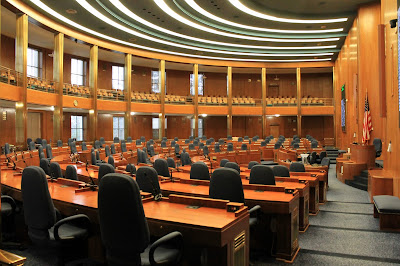We ended up staying in Bismarck for six days but did not do much exploring except for touring the capitol. We replenished our supplies after more than a week of small towns. We took advantage of the walking trail by the RV park and checked out a couple local eateries and the Laughing Sun Brewery. Our travel plans at this point are not only being dictated by the winds, but also by when the Penguins are playing. Both of those things are why we stayed here so long.
This capitol was built in the early 1930's after the original territorial capitol burned. The decision to build a skyscraper in the Art Deco style, rather than the more traditional domed building, was based on how much usable space they could get for the money they had budgeted. At 19 stories the building is the tallest in North Dakota. West Virginia is the only other capitol that is the tallest building in its state. It is one of four skyscraper capitols, Louisiana, Florida and Nebraska are the others.
On the ground floor is the Theodore Roosevelt Rough Riders Awards Hall of Fame. It honors those whose lives were shaped by their time in North Dakota. After Teddy, the first awardee was Lawrence Welk. Some of the others we recognized were Roger Maris, Peggy Lee, Eric Sevareid, Warren Christopher and Bobby Vee.
The two outer pieces show the states two main industries, mining and farming. The center is a relief on the elevator doors with scenes of state history with settlers and Native Americans fighting for the land, a covered wagon and a train, an early hunter and buffalo, the two main industries and a farmer and a rancher. The background is the wall of a small anteroom made of California walnut, a tree that has been wiped out.
The Great Seal of North Dakota has several appropriate symbols of the state. A lone tree surrounded by bundles of wheat, a plow, anvil and sledge, a bow with arrows and an Indian on horseback chasing a buffalo into the setting sun. There are forty three stars on the seal even though North Dakota was the 39th state. When the seal was adopted in October 1889 North Dakota was one of four states, along with South Dakota, Montana and Washington, entering the union that year. Since they did not know the order of their statehood they put 43 stars on the seal.
Legislative Hall is between the House and the Senate. The hall shows the Art Deco style with plain simple lines and the use of wood on the walls. The hall is forty feet high and has recessed seating areas that have acoustically designed tops making a private conversation possible in this large open space.
There are 94 members in the House of Representatives who are elected to four year terms with half up for election every two years. The legislature meets for 80 days every two years. The pillars and rails are bronze and the walls are American chestnut. The desks are American walnut. The lighting here is called Stars and Moon at Night. I missed the moon with my picture.
The rostrum is very simple yet eloquent with the seal, flags and chestnut walls. As with some other capitols, the House chamber is blue.
The Senate has forty seven members elected to four year terms with half up for election every two years. The walls here are English oak and the desks American oak. The lighting here is called Sunrise or Sunset. Again, as with some other capitols, this chamber is red.
The rostrum again is very simple while accenting the height of the chamber with the lights.
The 18th floor is an observation deck with a great view of the surrounding city and countryside, This is the tree lined lawn in front of the capitol. I guess it is not true that the North Dakota state tree is the telephone pole:)
This is the Library Memorial Building, the oldest building on the grounds and houses the Heritage Center.
The observation deck has many pictures of the old capitol and the building of this one. How about this one breaking the Guinness Book of World Records for the most snow angels on the capitol lawn. Very cool!!
Like all the plains states, the buffalo has played a big role in their history. This statue really captures this huge majestic animal.
We have been crossing the route used by Lewis and Clark since we were in Helena. This is Sakakawea, the Native American who, along with here French husband, served as interpreters for Lewis and Clark from North Dakota to the Pacific Ocean. She was a Shoshone who had been kidnapped at the age of 12 and taken as a wife by Toussaint Charbonneau when she was 13. She played a major role in the success of the mission exploring the Louisiana Purchase.
The Pioneer Family statue honors those early settlers who came to North Dakota. They had to be hardy people to leave the east and move to this wild, unsettled land.
The old governor's mansion is being replaced by a new, larger more modern house.
The North Dakota capitol and grounds is well worth a visit. The Art Deco style, which is different from most other capitols, has its own unique beauty.
Since leaving Bismarck we have been to Pierre to tour the South Dakota capitol, stopped a couple days in Mitchell to see the Corn Palace and the McGovern Library and are now in Sioux Falls to see my cousin and check out the area. Our plan has changed after we found ball bearings when we opened the living room slide in Mitchell. We have an appointment next week near Omaha to have it checked out.



















2 comments:
Every Capitol you visit is different.
No Daks are hardy people!
Post a Comment